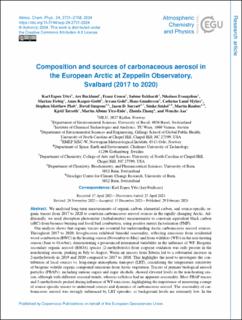| dc.description.abstract | We analyzed long-term measurements of organic carbon, elemental carbon, and source-specific organic tracers from 2017 to 2020 to constrain carbonaceous aerosol sources in the rapidly changing Arctic. Additionally, we used absorption photometer (Aethalometer) measurements to constrain equivalent black carbon (eBC) from biomass burning and fossil fuel combustion, using positive matrix factorization (PMF). Our analysis shows that organic tracers are essential for understanding Arctic carbonaceous aerosol sources. Throughout 2017 to 2020, levoglucosan exhibited bimodal seasonality, reflecting emissions from residential wood combustion (RWC) in the heating season (November to May) and from wildfires (WFs) in the non-heating season (June to October), demonstrating a pronounced interannual variability in the influence of WF. Biogenic secondary organic aerosol (BSOA) species (2-methyltetrols) from isoprene oxidation was only present in the non-heating season, peaking in July to August. Warm air masses from Siberia led to a substantial increase in 2-methyltetrols in 2019 and 2020 compared to 2017 to 2018. This highlights the need to investigate the contribution of local sources vs. long-range atmospheric transport (LRT), considering the temperature sensitivity of biogenic volatile organic compound emissions from Arctic vegetation. Tracers of primary biological aerosol particles (PBAPs), including various sugars and sugar alcohols, showed elevated levels in the non-heating season, although with different seasonal trends, whereas cellulose had no apparent seasonality. Most PBAP tracers and 2-methyltetrols peaked during influence of WF emissions, highlighting the importance of measuring a range of source-specific tracers to understand sources and dynamics of carbonaceous aerosol. The seasonality of carbonaceous aerosol was strongly influenced by LRT episodes, as background levels are extremely low. In the non-heating season, the organic aerosol peak was as influenced by LRT, as was elemental carbon during the Arctic haze period. Source apportionment of carbonaceous aerosol by Latin hypercube sampling showed mixed contributions from RWC (46 %), fossil fuel (FF) sources (27 %), and BSOA (25 %) in the heating season. In contrast, the non-heating season was dominated by BSOA (56 %), with lower contributions from WF (26 %) and FF sources (15 %). Source apportionment of eBC by PMF showed that FF combustion dominated eBC (70±2.7 %), whereas RWC (22±2.7 %) was more abundant than WF (8.0±2.9 %). Modeled BC concentrations from FLEXPART (FLEXible PARTicle dispersion model) attributed an almost equal share to FF sources (51±3.1 %) and to biomass burning. Both FLEXPART and the PMF analysis concluded that RWC is a more important source of (e)BC than WF. However, with a modeled RWC contribution of 30±4.1 % and WF of 19±2.8 %, FLEXPART suggests relatively higher contributions to eBC from these sources. Notably, the BB fraction of EC was twice as high as that of eBC, reflecting methodological differences between source apportionment by LHS and PMF. However, important conclusions drawn are unaffected, as both methods indicate the presence of RWC- and WF-sourced BC at Zeppelin, with a higher relative BB contribution during the non-heating season. In summary, organic aerosol (281±106 ng m−3) constitutes a significant fraction of Arctic PM10, although surpassed by sea salt aerosol (682±46.9 ng m−3), mineral dust (613±368 ng m−3), and typically non-sea-salt sulfate SO (314±62.6 ng m−3), originating mainly from anthropogenic sources in winter and from natural sources in summer. | en_US |

